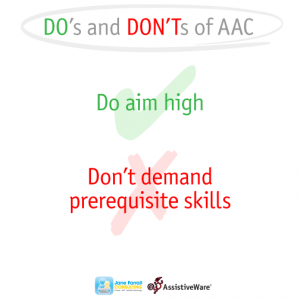In May this year David Niemeijer from AssistiveWare and I did a presentation at the AGOSCI Conference on the Do's and Don'ts of Implementing Real Communication Through AAC. We created a poster to accompany that blog post - and this is one of the follow ups to the poster.
In the last few weeks I have heard from several different teachers that they have been told by others that their student “isn’t ready for symbols”. I am always shocked that anyone can still say this in 2015 when we moved away from a candidacy model for AAC around 20 years ago.
So, how should we respond when people mention prerequisites for AAC?
Countering the candidacy model
In the 1970s and 1980s the candidacy model was in vogue. I graduated as a speech pathologist in the early 1990s and candidacy was still quite prevalent – but our practice was starting to shift to the participation model instead. Obviously this shift still needs to spread further!
A candidacy model is one in which individuals are considered “too” something for AAC. They might be “too young” or “too intellectually disabled” or “too linguistically delayed” or “too socially withdrawn”.
The result of a candidacy model is that some individuals are deprived of an AAC system and services. And this is where the candidacy model is controversial – because communication is a basic human right. And a communication system that doesn’t offer the individual the ability to learn to request, respond, negate, continue, and all the other communication functions is not good enough!

Thanks to Kate Ahern from Teaching Learners with Multiple Special Needs for this image of communicative functions.
The candidacy or readiness model was particularly problematic for individuals with multiple disabilities. According to Beukelman and Mirenda (2013) “”not ready for” criteria were [often] used as a result of misguided interpretations of research examining communication and language development in typical children”.
Kangas and Lloyd (1998) wrote a fabulous article addressing the concept of cognitive prerequisites. Among other things, they summarise research showing that an individual who is raised in a signing environment often learns to use signs earlier than typical children learn to use speech – which indicates that signing may be easier to learn to use. And while they recognize that there is a difference between signs and symbols, they go on to talk about a smaller body of evidence that individuals can learn to be expressive with picture symbols at a relatively early age and that individuals with “severe mental retardation” were able to learn to use symbols to communicate although they weren’t using speech. This article strongly put the case for a shift away from the candidacy model for AAC.
Romski and Sevcik (1988) also wrote an article that helped with this shift. They specifically addressed AAC and individuals with severe intellectual disabilities and demonstrate that the research literature suggests that the "relationship between cognitive, communicative, and linguistic skills is not as predictable as it might have been viewed initially by child language investigators”.
Now I have to say that I’m a pretty major fangirl of Romski and Sevcik – I refer people to their article about Augmentative Communication Myths (Romski & Sevcik, 2005) many times every year. They also address this myth of prerequisite skills in this article – it’s myth #3. You can read the article by clicking on the link above, but I love the way they simply state “Some individuals with severe sensori-motor disabilities cannot demonstrate their cognitive abilities without a means by which to communicate so we cannot insist on evidence of those abilities before providing AAC services and supports.”
Promoting the Participation Model
The candidacy model was replaced by the participation model. The participation model (Beukelman & Mirenda, 1998, but first proposed in 1988) is a systemic process for implementing AAC through assessment and intervention, based on the functional participation requirements of peers without disabilities who are the same age. The participation model gets us to make two sets of AAC decisions – one set for “today” and one set for “tomorrow”. This is important because we know communication development doesn’t happen straight away – but we are also increasingly recognizing that for every individual to move towards communicative competence (Light & McNaughton, 2014) we need long term support and intervention.
The participation model comes from a mind set that considers the other side of the argument to the candidacy model. Rather than looking at prerequisites, it considers all the research we have demonstrating that the use of AAC has a positive effect on communication abilities – and that therefore we need to implement AAC to see communication develop. When Kangas and Lloyd (1988) discussed this side of the argument against the candidacy model they cited research showing that AAC has been shown to assist with the development of language comprehension and speech. We are now nearly 20 years past 1988 and we have an even bigger body of research demonstrating this.
In particular, we have a growing body of research showing the importance of aided language stimulation (ALS) – where we need to communicate with individuals using both symbol based AAC and speech to help them develop communication, and we use ALS on the way towards a system for tomorrow for every individual with complex communication needs. Dada & Alant (2009) demonstrated how ALS could be used to build an individual’s receptive vocabulary – with only 3 weeks of input. Imagine what we could do long term! Drager et al (2006) and Harris and Reichle (2004) demonstrate that ALS can have positive benefits both on receptive and expressive language. And this is only some of the evidence we have of the efficacy of aided language stimulation! In the AAC Services Standard published by Communication Matters (2012) for the UK, modelling is listed as part of the important tools in a rolling model of support, similar to the participation model in that regular assessment, intervention, review, assessment are recommended.
So, how should we respond when people mention prerequisites for AAC?
We need to tell them that this is an outdated way of thinking about AAC intervention. The American Speech-Language-Hearing Association (2004) endorsed the Participation Model as a framework for carrying out AAC assessments and interventions. It is also considered to be an important framework for AAC assessment and implementation by Speech Pathology Australia (2012). In the participation model, prerequisites are seen as an opportunity barrier that needs to be addressed and removed and all of us interested and involved in AAC need to work towards these barriers disappearing forever.
Or in the words of from Professor Carole Zangari (2013) at PrAACtical AAC in an article about AAC prerequisites:
“It’s fine to ‘party like it’s 1999,’ but let’s not practice SLP that way.”
References
American Speech-Language-Hearing Association. (2004). Roles and responsibilities of speech-language pathologists with respect to augmentative and alternative communication: technical report [Technical Report]. Available from www.asha.org/policy.
Communication Matters(2012). Quality Standard for AAC Services. Available from www.communicationmatters.org.uk
Beukelman, D., & Mirenda, P. (1998). Building opportunities and nonsymbolic communication. In D. Beukelman & P. Mirenda (Eds.), Augmentative and Alternative Communication (2nd Ed., pp. 265–294). Baltimore: Paul H. Brookes.
Beukelman, D. R., & Mirenda, P. (2013). AAC: Supporting Children and Adults with Complex Communication Needs. 4th Edition. Baltimore, Maryland: Paul H. Brookes.
Dada, S. & Alant, E. (2009). The Effect of Aided Language Stimulation on Vocabulary Acquisition in Children With Little or No Functional Speech. Am J Speech Lang Pathol, 18(1), 50-64.
Drager, K. D. R., Postal, V. J., Carrolus, L., Castellano, M., Gagliano, C., & Glynn, J. (2006). The Effect of Aided Language Modeling on Symbol Comprehension and Production in 2 Preschoolers With Autism. Am J Speech Lang Pathol, 15(2), 112-125.
Harris, M. D. & Reichle, J. (2004). The Impact of Aided Language Stimulation on Symbol Comprehension and Production in Children With Moderate Cognitive Disabilities. Am J Speech Lang Pathol, 13(2), 155-167.
Kangas, K. & Lloyd (1988) Early cognitive skills as prerequisites to augmentative and alternative communication use: What are we waiting for?, Augmentative and Alternative Communication, 4(4), 211-221
Light, J., & McNaughton, D. (2014). Communicative competence for individuals who require augmentative and alternative communication: A new definition for a new era of communication? Augmentative and Alternative Communication, 30, 1–18.
Romsk, M.A. & Sevcik, R.A. (1988) Augmentative and alternative communication systems: Considerations for individuals with severe intellectual disabilities, Augmentative and Alternative Communication, 4(2), 83-93
Romski, M.A. & Sevcik, R.A. (2005) Augmentative communication and early intervention: myths and realities. Infants and Young Children 18 (3), 174



Cara
jane
Patricia
jane
jane kleinert
jane
Lisa W.
Di K.
jane
Marlene
jane
The Communication Toolbox
jane
nat
jane
Dan
jane